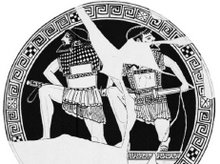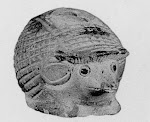I've just written a long article on the mechanics of hoplite battle for the Marathon Special issue of Ancient Warfare magazine (http://www.ancient-warfare.com/cms/ancient-warfare/guidelines/editorial-plan-2.html). I will be in good company, because the editors have secured articles by some of the top thinkers on ancient Greek warfare, like Krentz and Sekunda.
My article, which I think will have the final title, "The mechanics of hoplite combat: reconciling storm of spears with press of shields", is a bit over 6,000 words and crammed with many of the concepts I discuss on this blog. The goal of the article is to reconcile the increasingly divergent views of the "orthodox" and "heretical" views of hoplite combat. If you've been reading, then you know that I believe most of the differences evaporate once we understand the mechanics of masses of men in motion. The heretics in general don't understand how men could survive a physical push by all ranks, while the orthodoxy does not present realistic mechanics for men doing so. Were it not for the fact that they both veer away from their fields of expertise and into mine, I would have nothing to add to the discussion. But because they do, often making assertions that they are unqualified to make, I have an opportunity to bring about syncretism. To paraphrase Dr. Krentz, I have no expectation that my recommendations will be followed, but the argument should reach a larger audience now.
One thing that I have done in this article is to update the presentation of the crowd-othismos from my 2007 article. In that earlier article I specifically presented the new form of othismos as a counter to the prevailing orthodoxy. Because I wrote within the paradigm of the orthodoxy, the earlier article left the impression that battles had to start with a collision. In this article, I have shown what I have discussed on this blog for some time, that the physical collision of men more likely occurred after a period of spear-fighting. This is because the density of the crowd is far more important to the transmission of force than the speed of advance. Hence the storm of spears, then press of shields all formed part of the experience of most hoplite battles. Often, one side gave way "at spear's length" before othismos, and sometimes I believe there was an initial collision, as during the second phase of Coronea, "a battle like no other", but the threat of both phases of battle was always present.
I haven't posted for a while, but I have been banking up information. Once the article comes out, there will be a flurry of posts to provide supporting material. I have many diagrams I did for the article that will find their way into posts.
So, check back over the next month or so because things will heat up.
Subscribe to:
Post Comments (Atom)





5 comments:
Great hearing that you have more articles and posts in the pipeline! Will you go to the Marathon anniversity in September?
With all the reenactors there it would be sweet if you could get some volunteers to do some experiments in pushing.
Hey Daniel,
Unfortunately time and money pressure have conspired to keep me from Marathon. Of course if anyone wants advice on how to test elements of hoplite combat, I'm always glad to assist if they are willing to do it in the proper manner.
Mr. Bardunias,
What exactly is your field of expertise?
Hey Dan,
Thanks for your question. I wrote my answer in a new post because others may be curious as well.
hello, i've just found your blog, and i've been pouring it over for the last few days.
I'm a videogame enthusiast, and you may or may not know of a 2004 PC game called Rome Total War. I was a huge fan of it, and a sequel is due next year. It's depiction of ancient warfare, both phalanx and cohort, was arresting to my young mind, even if it was somewhat dumbed down or historically suspect.
With a sequel now in the works, the forums are awash in armchair generals and history nerds debating how the game should more closely reflect the mechanics of warfare of the age, and among the usual internet shouting and trolling and unsupported opinions, there is a genuine desire to understand the realities of combat of the age.
Anyway, I ramble, but I have to say your blog has been a great read! Even from the first few posts, I knew that your vision of the mechanics of hoplite warfare was ringing true to me, in that it finally seems to make sense. In the way that any martial art does when you look at its mechanics, its weapons, its equipment, and the character of its participants and their valuation of it.
So thanks! You've been instrumental in my understanding of this most interesting period of western war-making.
cheers!
Post a Comment